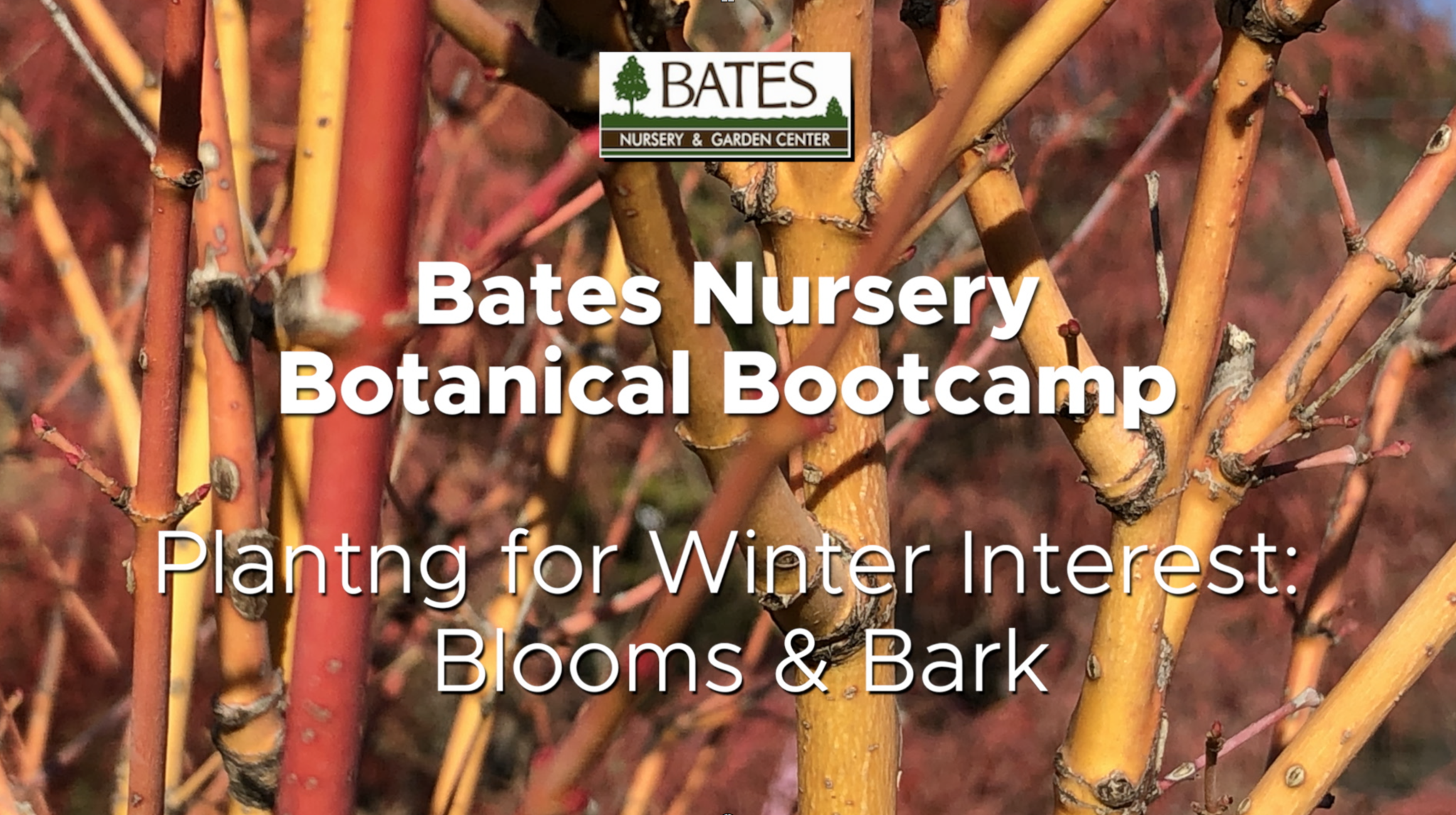Planting for Winter Interest: Blooms and Bark
- Posted on
- Posted in Ornamental Gardening, Winter Interest
- 0

Ben Trest whisks us away to a world of plants that defy nature's wish of quiet dormancy during the wintertime. Topics include types of plants that bloom during the winter and early spring, plants with showy bark and/or berries, and seasonal leaf color.
Plants Mentioned in this Webinar:
Plants for Fall Color:
Trees
Deciduous Trees:
Dogwood/Cornus Good tree for understory & along wood lines
Blackgum/Nyssa sylvatica-very hardy, can take a range of conditions.
Coral Bark Japanese Maple/Acer palmatum ‘Sango Kaku’-goes from green to yellow to a brilliant orange. Has coral-hued bark for winter interest.
Shrubs
Deciduous Shrubs:
Viburnum (Brandywine Viburnum) -Native species, brilliant red fall color & blooms in the spring.
Sweetspire/Itea-very bright and consistent fall color. Durable and tough bush
Perennials
Bluestar/Amsonia-brilliant yellow-orange fall color. Looks nice in masses
Evergreens
Bronzing-when an evergreen changes color into the winter. Amount of bronzing depends on sun-more sun = more bronzing
Evergreen Shrubs
Winter Gem/Buxus micro var japonica ‘Winter Gem’
Wintergreen/Buxus micro var japonica ‘Winter Green’
Unravel Buxus sempervirens ‘Unravled’
Mushroom/Cryptomeria ‘Mushroom’-green during the year, but turns yellow to purple as the temps drop.
Leucothoe-purple to reddish tones
Yucca-evergreen, drought-tolerant, can take a lot of cold and sun.
Yucca ‘Color Guard’-bright, variegated leaves.
Crossvine/Bignonia-native plant. Evergreen vine. Turns a red/purple color in the winter. Good for screening and to create privacy screens
Heavenly Bamboo/Nandina-does well in full sun
Evergreen Perennials
Dianthus-creeping groundcover
Coral Bells/Heuchera-full shade to part sun. Comes in many colors.
Ferns-shade to part sun.
Autumn Fern-turns bronze and orange in the fall.
Lenten Rose/Helleborus-bloom in the early spring
Winter Blooms
Camellia-plant in a protected area with morning sun and afternoon shade.
Camellia japonica ‘April Dawn’
Learn more about camellia care and varieties.
Winter Jasmine/Jasminum nudiflorum-ground cover plant. Good for sides of driveway, wall, road frontage. Blooms bright yellow mid-winter. Large vining shrub.
Witch Hazel/Hamamelis-native plant. Large bush to small tree. Frilly unique blooms in the mid-winter
Hydrangea-keep the blooms on and intact for winter interest. Especially paniculata varieties.
Winter Texture
Ornamental Grasses-leave seedheads on for movement and color in winter landscapes. Some will bronze in the fall as well. Seedheads also feed birds and wildlife.
Sedge/Carex-evergreen. Good for adding color and texture in shaded areas.
Winter Berries
Learn what to plant to attract birds and wildlife to your garden in the winter months.
Ilex ‘Red Beauty’-nice dwarf
Deciduous Holly/Ilex-These get 8-10’ tall.
Beautyberry/Callicarpa-bright purple berries
American Beautyberry/Callicarpa
Juniper/Juniperus-wildlife will feed on the blue to black berries.
Cotoneaster-low growing, spreading evergreen with bright red berries.
Winter Texture: Bark
Coral Bark Maple/Acer palmatum ‘Sango Kaku’-bright reddish/pinkish bark.
Bihou/Acer palmatum ‘Bihou’-stays smaller. Leaves turn yellow, trunks turn red to yellow.
Rough Bark Japanese Maple/Acer palmatum ‘Arakawa’-Knotty, beautiful bark.
River Birch/Betula-peeling, exfoliating bark
Fox Valley-Dwarf River Birch/Betula
Red/Yellow Twig Dogwood-good in naturalized gardens. Yellow twigs tend to get bigger. 8-10’
Arctic Fire/Cornus 'Arctic Fire'
Register for the next Bates Nursery Botanical Bootcamp session here.

Comments
Be the first to comment...